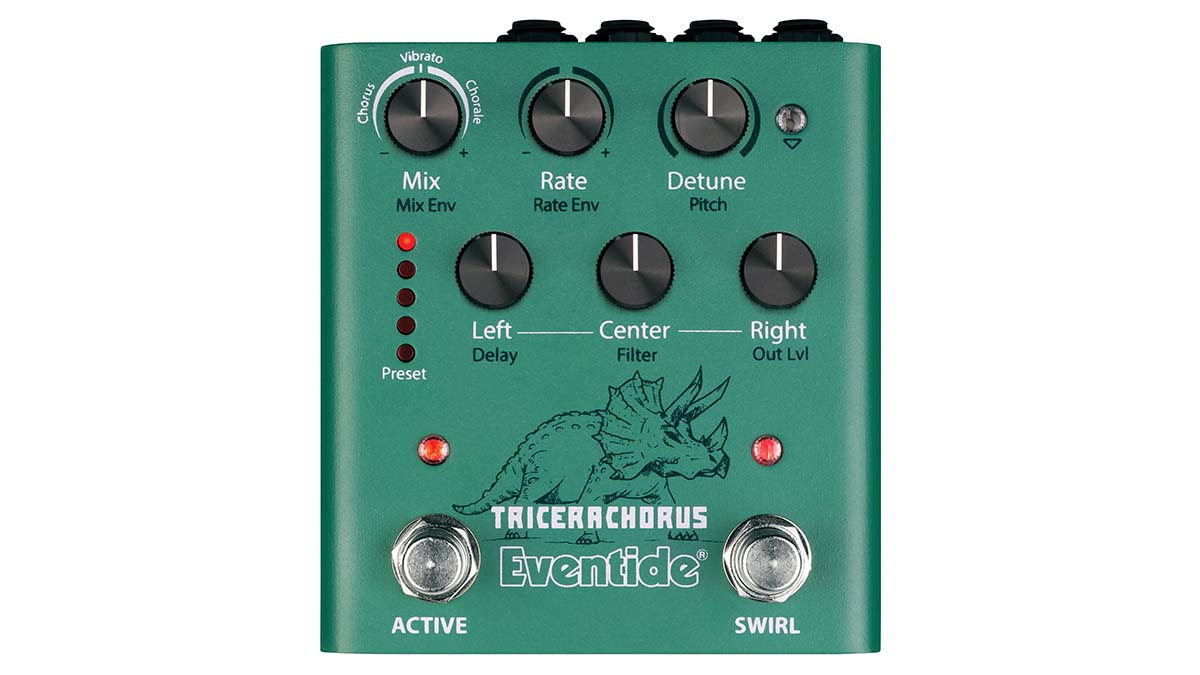Eventide unveils the TriceraChorus, a modulation powerhouse it calls its “lushest chorus ever”
This stereo bucket brigade-style tri-chorus offers vintage chorusing and heady psychedelic textures with its Swirl and MicroPitch detuning capability

Eventide Audio has had a good old fossil dig through classic stompbox and rackmounted effects units of yore and come up with what might just be one of the most versatile chorus pedals on the market.
The TriceraChorus is a bucket brigade-style chorus with full stereo operation, presets, and a dizzying array of features, that complement its vintage chorus voicings with 21st century functionality.
Arriving in similar housing to Eventide’s superlative UltraTap Delay and MicroPitch Delay, the TriceraChorus is similarly packed with features and sounds, and new modes of tweaking them for performance.
The TriceraChorus applies Eventide’s clever MicroPitch detuning technology to bucket brigade chorus, deploying a trio of independent chorus voices – left, centre and right – each of which can be manipulated and deepened with MicroPitch.

The three voices can also be combined for an epic wash of chorus that would probably be ruled too 80s for the 80s, with a three-phase LFO modulating the delay times for each of the chorus voices and adding no shortage of movement in your tone – an effect made wider and all the more immersive should you run this in a stereo rig.
Fundamentally, there are three types of chorus on offer – Chorus, Vibrato and Chorale – each selectable via the Mix knob. This being Eventide, the controls are pulling double shifts, with their secondary functions in darker text under each knob.
The Chorus mode is voiced for classic chorusing, Vibrato gives you a “warbly, pulsing effect” while Chorale is inspired by classic rackmounted tri-chorus units and will surely come into its own should you get a gig in a new-wave band.
Want all the hottest music and gear news, reviews, deals, features and more, direct to your inbox? Sign up here.




There are two footswitches on the enclosure. Active can be used in momentary or latching mode to turn the effect on, while Swirl offers a short-cut to heady psychedelic tones, and is on hand for flanging, phasing and Uni-Vibe-style sounds – it will have a different effect depending on whichever chorus mode you are in.
The TriceraChorus comes with five presets already loaded, but you can create and access dozens more with the complementary Eventide Device Manager (EDM) software.
Like its siblings in the Eventide lineup, any parameter can be mapped to an expression pedal. You can also hook up a simple auxiliary switch for tap tempo, or a three-button switch for cycling through your presets.
The pedal has MIDI capability over TRS or USB, and there are multiple bypass options, including buffered, relay, DSP+FX or Kill dry.
Of course, we are looking at this from an electric guitar point of view, but with a Guitar/Line Level switch on the rear of the unit, you can match the levels for vocals and synthesizers – or adjust it for DAW or guitar amp’s effects loop.
The TriceraChorus is available now, priced £305. For more details, see Eventide Audio.
Jonathan Horsley has been writing about guitars and guitar culture since 2005, playing them since 1990, and regularly contributes to MusicRadar, Total Guitar and Guitar World. He uses Jazz III nylon picks, 10s during the week, 9s at the weekend, and shamefully still struggles with rhythm figure one of Van Halen’s Panama.
